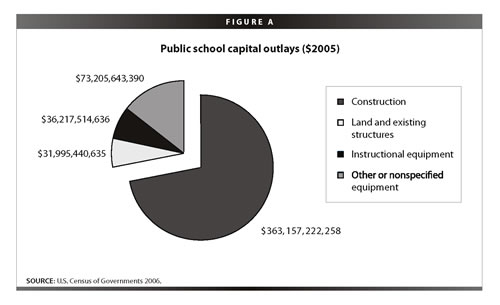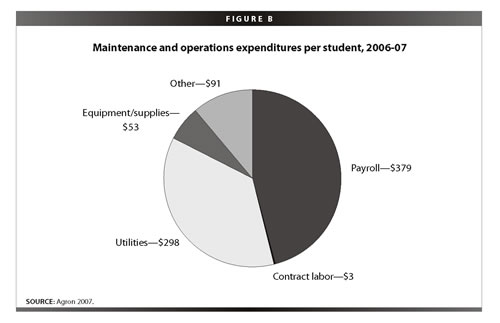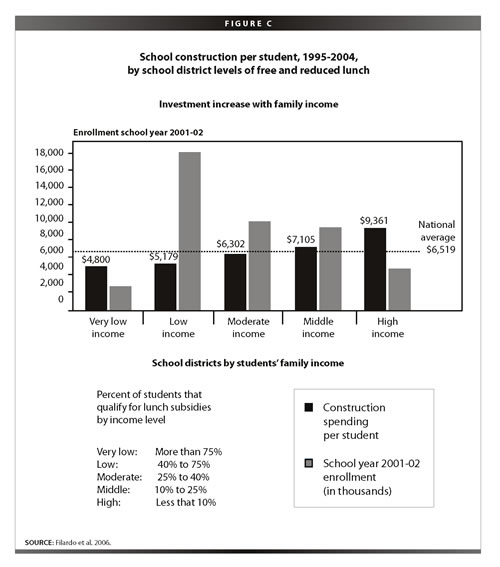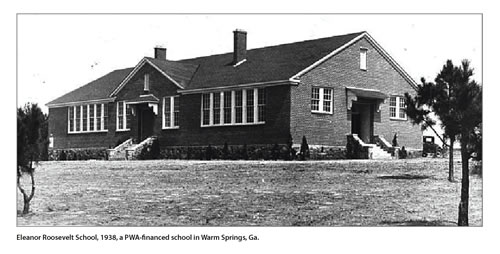Briefing Paper #216
The nation’s 97,000 public school buildings comprise an estimated 6.6 billion square feet of space on over 1 million acres of land. And while states and local communities invested over $500 billion in K-12 school building improvements from 1995 to 2004, considerable additional investments are needed to ensure that the nation’s public schools are healthy, safe, environmentally sound, and built and maintained to support a high-quality education.
Today, many of the nation’s schools face the combined challenges of deteriorating conditions, out-of date design, and changing utilization pressures (including intense overcrowding in some communities and rapidly declining enrollments in others). These combined deficiencies impair the quality of teaching and learning and contribute to health and safety problems for staff and students. Building design and facility conditions have also been associated with teacher motivation and student achievement.
Economic conditions in the United States have prompted serious discussions about the need for federal stimulus spending. In this context, the deteriorating physical condition of the nation’s public schools actually presents an opportunity for federal spending that is targeted to near-term growth, by creating high-quality jobs, and that provides long-term benefits by building a better learning environment. A $20 billion maintenance and repair initiative could eliminate years of deferred maintenance, particularly in schools in low-income communities. It could also generate 250,000 skilled maintenance and repair jobs and supply $6 billion of materials and supplies. Another federal investment—$50 billion in capital funds for the lowest-income school districts—would be targeted, timely, and temporary and address the inequity in capital outlays of the last decade. Finally, an ongoing federal role in capital funding, comparable to the federal share in operating funding of approximately 10% of state and local spending, would help ensure that one of the nation’s most important enterprises—the education of its children—has the facilities to generate dividends.
The scale of public school infrastructure in the U.S.
In fall 2007, approximately 49 million students were enrolled in about 97,000 public schools.1 No national inventory or assessment of K-12 public school buildings is available in the United States, and not all states maintain an inventory of basic information on the size, age, condition, or capacity of their public school buildings. An estimate of the total amount of space in the nation’s public schools, prepared by the 21st Century School Fund using projected public school enrollment for the fall of 2007 and average space standards for school buildings, is shown in Table 1. The estimate assumes 120 or 165 gross square feet per student, depending upon grades offered, for a total of 6.6 billion gross square feet for the nation’s 97,000 public schools.2

In addition to building space, schools also utilize extensive land and site amenities such as roads, parking, lighting, sidewalks, storm water management systems, athletic fields, recreational areas, and green space. Using a similar approach to estimate the total land area utilized by public schools yields a conservative estimate of over 1 million acres (Table 2).3

Another indication of the size of the public school inventory is the capital outlay reported in the U.S. Census of Governments. During the 1995-2004 period, the combined expenditures for K-12 school building improvements—including new construction, renovation, major maintenance and repairs, land, and equipment— were approximately $504 billion (Figure A). Over 85% of these capital expenditures were facility related.

Deteriorating conditions in the public schools
Like basic inventory on school buildings and land, assessments of building and site condition, design, and utilization are also not available at the national level and are not readily or universally available at the state level. The National Center for Education Statistics, in its congressionally mandated report The Condition of Education, includes no information about the condition of elementary and secondary public school building infrastructure.
The management of school facilities is a local responsibility, but one that local communities and school districts are struggling to meet. However, evidence abounds that, even after over $500 billion of capital outlays in the decade between 1995 and 2004, public school facilities, particularly in low-wealth communities, have substantial deficiencies.
In 31 states, plaintiffs have challenged the adequacy or equity of public education funding in low-income communities and have made facility conditions an element of their lawsuits. In four states, the condition of facilities was the exclusive focus of the suit (Education Law Center 2006). Another indicator that serious building deficiencies are the norm rather than the exception is the American Society of Civil Engineers report card on infrastructure. The society began including public schools in its infrastructure report card in 1998; in that year it gave public schools an F, followed by a D- in 2001 and 2003, and a D in 2005. While this is progress, as one would hope after a half-trillion dollar investment during 1995-2004 the still-low overall grade indicates how great the needs were in 1995 and how challenging it is to keep up with building maintenance, lifecycle replacements, new educational design, and enrollment change. And, of course, the overall national grade says nothing about how badly certain states and localities are failing.
Substandard conditions, design, and utilization take many forms. Poor school design and facility conditions can lead to “sick building syndrome,” according to the Environmental Protection Agency (EPA 2000). Two-thirds of teachers in the District of Columbia reported poor air quality in their classrooms (Schneider 2003). The General Accounting Office (GAO 1995) found that one in five students nationwide attends a school that suffers from poor ventilation; poor ventilation can boost rates of asthma and respiratory illness, both of which are disproportionately observed in urban schools (EPA 2000). The temperature and humidity in classrooms can affect children’s health and motivation. One study of Florida classrooms found many with mold growing inside ceilings, triggering allergic symptoms (Bates 1996).4
Public school districts face problems not only with the basic condition of their buildings, but also with the need to modernize old or obsolete building design.
- Early childhood education, which has expanded from a half-day of kindergarten to full-day programs for three-year-olds, particularly in school districts serving low-income families, requires changes in classroom design. Early childhood classrooms need bathrooms, special furniture, easy access to the out-of-doors, more space for adults, and more space for gross motor play.
- Technology should be ubiquitous for instruction, security, and administration. School buildings need voice, video, and data highways throughout their facilities and electrical upgrades to support the computers, audio-enhanced classroom technology, smart boards, and other classroom technology aids that have the potential to help close achievement gaps and improve the basic quality of teaching and the productivity of teachers. Among the cohort of students who can benefit most from education technology are special needs students.
- Science education would benefit from facility-related improvements, whether for safety or for quality. The National Science Teachers Association (NSTA) recommends that students spend 50% of their time in hands-on, inquiry-based science. In their guide to planning science facilities, the NSTA states: “Good science programs require the uniquely adaptable learning space we call a laboratory, as well as access to both indoor and outdoor space for research, environmental studies, and reflection. Yet the vast majority of communities moving toward the Standards will find their progress limited by the facilities available in their schools” (Motz et al. 2007).
In addition to condition and design challenges, many school districts face either increasing or declining enrollments that require them to either build new inventory or reduce inventory to meet their changing demographics. Fully half of the $363 billion spent on school construction over the 1995-2004 decade was to address enrollment increases (Filardo et al. 2006). Ten thousand schools were added to the nation’s public school inventory between 1995 and 2005.
How is the quality of public school facilities important?
In a March 2008 report on improving California’s infrastructure, authors Dowall and Ried describe infrastructure in terms of the public benefits it brings. So rather than thinking of infrastructure in terms of transit, roads, bridges, and waterways; reservoirs, water supply, and sewers; landfills, parks, and other public lands; schools, colleges, and universities; and prisons, jails, and courts, they describe it in terms of the services this infrastructure supports—”mobility; safe and reliable sources of water; sustainable development; knowledge creation and transfer; and personal security.” This perspective is important to a discussion about school infrastructure, because the issue is not the buildings themselves, but what we need them for—in the case of public schools, for knowledge creation and transfer.
Public school districts need to improve the quality of education so that coming generations make greater progress against international and domestic conflicts, poverty, disease, and the degradation of the environment. School districts need to graduate students who will successfully compete globally, and they need to close the achievement gaps between children from advantaged and disadvantaged cohorts to achieve this goal. Public Schools and Economic Development: What the Research Shows (Weiss 2004) examines research linking educational investment to national productivity and correlating educational quality and quantity to wages, productivity, and social equity. It concludes, “Taking the research as a whole—including studies focused on both domestic and international data, as well as various theories discussed—the findings strongly indicate that a nation’s educational system helps determine the quality of its labor force and therefore the health of its economy.”
Many of the key educational initiatives designed to give the nation’s children the tools and knowledge they need for the future have facility-related implications. Building deficiencies impair the quality of teaching and learning and contribute to health and safety problems of staff and students. Building design and facility conditions have also been associated with teacher motivation and student achievement. For example, classroom lighting and thermal comfort are commonly cited by teachers as determinants of their own morale and the engagement of their students (Corcoran, Walker, and White 1988; Jago and Tanner 1999). Lemasters (1997) identified 53 studies that linked design features to student achievement.
Two studies (Lewis 2000; Buckley, Schneider, and Shang 2004)—one in Los Angeles and the other among Milwaukee schools—directly observed school conditions and controlled for pupil and neighborhood socioeconomic characteristics, school size, and students’ reported motivation levels. Facility conditions and maintenance variables included conditions of lockers, visible graffiti, and frequency of cleaning classrooms. The studies found higher reading scores among elementary and high school students in better-maintained schools, after accounting for the other influences.
While the quality of public school buildings is most essential for the school-age population that is compelled to attend school and the over 6 million teachers and other adults who work in schools and school districts, these community-based facilities can and often do serve a much wider community. They are a public commons in many communities, accessible for public meetings, voting, and emergency shelters, as well as for use by private community groups and organizations that might have programs or services after school hours. Public school buildings, which are among the most common public buildings, often define and anchor neighborhoods and communities.
What can investment in K-12 public school facilities do?
Immediate spending on public school maintenance and repair can benefit the economy and at the same time improve education quality and even health. Capital investment that will affect a two- to five-year economic future will improve schools and communities and create lasting benefit to society, particularly if this capital investment is used to help close the achievement gaps between low-income students and their more-affluent peers.
Reduce the backlog of maintenance and repairs
School districts must maintain their school buildings on an annual basis. The Maintenance and Operations Cost Study, which is developed based on surveys of school business officials, estimates the per student spending on maintenance and operations for the 2006-07 year at $824 per student, approximately 9.2% of total district operating expenditures (Figure B breaks this total down to its individual components). Using this per-student estimate, total maintenance and operations spending nationally for the 49 million public school students would be approximately $40 billion for the 2006-07 year. Excluding utilities, the expenditure would be approximately $26 billion.

Maintenance and repair as well as custodial and budgets are often underfunded, and maintenance is often deferred over a period of years. For example, the Portland Public Schools estimate an $800 million deferred maintenance backlog and the Los Angeles Unified School District estimates a $5 billion backlog in their existing facilities. Particularly given rising utility costs, basic building cleaning, expanding early childhood education, and the pressure to reduce class sizes, maintenance and repair are cut back to address other demands on school district budgets. The overall percentage of school district spending on maintenance and operations declined from 12.75% in 1988 to 7.58% in 2006; it rose to 9.19% in 2007, largely due to rising costs of utilities (Agron 2007).
A $20 billion, one-time federal contribution to school districts to eliminate some of their deferred maintenance could generate close to 250,000 skilled maintenance jobs with nearly $6 billion for materials and supplies.5Maintenance and repairs at schools will improve health, help retain students and teachers in the school, and make the school environment more conducive to high-quality teaching and learning.
Reduce disparity in overall building quality
Schools in districts with a higher proportion of low-income children had less funding for new construction, renovations, and major maintenance and repairs than schools with more affluent student populations (Filardo et al. 2006). As is illustrated in Figure C, schools in districts where more than 75% of the students were eligible for free or reduced-price lunch, had, on average, only $4,800 per student invested in school construction over the 10 years between 1995-2004. Over the same period, the most affluent schools, where less than 10% of students were eligible for free or reduced lunch, had $9,361 invested in school construction.

To bring the very low-, low-, and moderate-income districts up to parity with the middle-income districts would require additional funding for these districts of about $50 billion. Funding all districts to the level of the highest income districts would require nearly $140 billion. Targeted funding for major capital improvements can reduce disparity and help low-wealth districts close the achievement gap.
Establish a federal commitment to ongoing facility funding for school districts serving low-wealth communities
Targeted, timely, and temporary help for states and school districts will help them eliminate building deficiencies in elementary and secondary public school buildings and eliminate the disparity that characterized school construction capital improvements during the previous decade. However, the federal government needs to play an ongoing role in school construction. While the need for an economic stimulus is contributing anew to discussions about federal funding for public school facilities, the federal government has had a major role in public school construction before. Between July 1933 and March 1939, the Public Works Administration (PWA) funded the construction of more than 34,000 projects, including thousands of public buildings. Seventy percent of the new schools built during these seven years were paid for by the PWA.6
Federal funding of school construction should not just be a tool of economic stimulus, but it should also be part of the long-term responsibility of the federal government to ensure that school districts, particularly those with high proportions of low-income, special education, and English-language learners, have adequate resources to provide appropriate schooling. Just as the federal government contributes, on average, 10% of local school district operating budgets, the federal government should provide a comparable amount for capital. Using the $504 billion from the 1995-2004 period as a basis for establishing local and state effort plus the $85 billion that the states and local school districts paid in borrowing costs over the period, would translate to a 10% federal contribution of $5.89 billion per year.
Public education—including the built infrastructure to support it—is key to the economic prosperity of our communities and nation. Responsible management and investment in public school buildings pays three times: once for skilled jobs in local communities; a second time in the quality that healthy, safe, and educationally appropriate buildings create for students and their teachers; and finally, a third time in the benefits that quality education will reap for generations to come.
—Mary Filardo founded 21st Century School Fund in 1994 to provide the District of Columbia and other urban communities with leadership, innovative financing solutions, research, and public policy analysis of school facility issues. She is a leading national authority on school facility planning, management, and financing, and she has written extensively on these public school facility issues. She serves on the Advisory Boards of the National Clearinghouse for Educational Facilities, Save Our Schools New Orleans, and the Center for Cities & Schools at the University of California, Berkeley. She is also a member of the International Program Advisory Board of the Public Education Network and the national jury for the Richard Riley Award for Schools as Centers of Community.

Endnotes
1. National Center for Education Statistics, 2007 Digest, Table 2; number of schools is the latest reported by NCES for 2005-06.
2. To give an idea of how this GSF estimate compares to actual state or school district standards, the District of Columbia uses 140 GSF per student at the elementary level as a space standard, Massachusetts uses 145 to 180 GSF, and Utah uses 72 to 125 GSF.
3. School site sizes can vary tremendously depending upon whether they are located in central cities, suburbs, or rural areas, as well as by school size, and these estimates are extremely conservative. The recommended size, for example, in Montgomery County, Md. for a high school of 1,500-2,000 students is 40 acres. The average high school site size for high schools in the District of Columbia is 10 acres.
4. Similar detrimental health effects have been reported by Bates (1996) and Jago and Tanner (1999), as well as Boese and Shaw (2005), in a study conducted for the New York State Department of Education
5. An average maintenance salary for 2007 of $42,311 per year, with a 28% add-on for benefits, works out to an annual salary of $54,158.
6. Eleanor Roosevelt Papers Project, George Washington University, Department of History; Public Works Administration; www.gwu.edu/~erpapers/teachinger/glossary/pwa.
References
Agron, Joe. 2007. 36th Annual Maintenance and Operations Cost Study: Schools. School Planning and Management Magazine, April.
Bates, J. 1996. Healthy learning. American School and University, 68: p. 27-29.
Boese, S., and J. Shaw. 2005. “New York State Schools Facilities and Student Health, Achievement, and Attendance: A Data Analysis Report.” Washington, D.C.: Healthy Schools Network. http://www.healthyschools.org/documents/NYS_SchoolFacilityData.pdf.
Buckley, J., M. Schneider, and Y. Shang. 2004. Los Angeles Unified School District School Facilities and Academic Performance. Washington, D.C.: National Clearinghouse for Educational Facilities.
Corcoran, T., J. Walker, and J. White. 1988. Working in Urban Schools.Washington, D.C.: Institute for Educational Leadership.
Dowall, David, and Robin Ried. 2008. Improving California’s Infrastructure Services: The California Infrastructure Initiative.Berkeley: University of California, Berkeley Institute of Urban and Regional Development.
Education Law Center. 2006. Safe and Adequate: Using Litigation to Address Inadequate K-12 School Facilities. Newark, N.J.: Education Law Center.
Environmental Protection Agency. 2000. Indoor Air Quality and Student Performance. Washington, D.C.: EPA (No. EPA 402-F-00-009).
Filardo, Mary, et al. 2006. Growth and Disparity: 10 Years of U.S. Public School Construction 1995-2004. Washington, D.C.: 21st Century School Fund, Building Educational Success Together.
General Accounting Office. 1995. School Facilities: American’s Schools Not Designed or Equipped for the Twenty-First Century.Washington, D.C.: GAO (ED383056).
Jago, E., and K. Tanner. 1999. Influence of the School Facility on Student Achievement. Athens, Ga.: University of Georgia.
Lemasters, L. 1997. A Synthesis of Studies Pertaining to Facilities, Student Achievement, and Student Behavior. Blacksburg: University of Virginia, Educational Leadership and Policy Studies Center.
Lewis, M. 2000. Where Children Learn: Facility Condition and Student Test Performance in Milwaukee Public Schools. Scottsdale, Ariz.: Council of Educational Facility Planners.
Motz, LaMoine L., James T. Biehle, and Sandra S. West. 2007. NSTA Guide to Planning School Science Facilities. 2nd Ed. Arlington, Va.: National Science Teachers Association Press.
Schneider, M. 2003. Public School Facilities and Teaching: Washington, D.C. and Chicago. Washington, D.C.: 21st Century School Fund.
Weiss, Jonathan. 2004. Public Schools and Economic Development: What the Research Shows. Cincinnati, Ohio: KnowledgeWorks Foundation.
